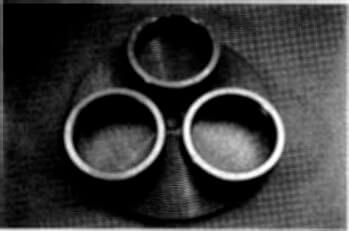The Technique of Lapping
The Working Plate
The usual material for the working plate during a lapping and polishing process is gray cast iron. The structure should be fine-grain, and free of blow-holes.
For lap-polishing, especially when using diamond grit, plates of steel, copper, zinc, aluminum or even wood that’s most commonly in use. When ultra-fine polishing, the working plates of pitch, plastic, fabrics or pads are what will output surface roughness. Each depend on the finish one is trying to accomplish to decide which would best suit your process. Today, all the crucial parts of a lapping machine can be designed for optimal mutual efficiency. If minimum wear is required, for example, the working plate can be made of sufficient hardness. Although, in view of the ease with which continuous reconditioning can be performed, soft to medium-hard plates are most often used. These have the additional advantage of being cheaper than harder plates.
Working Plate Shape
Once a lapping plate acquires an imperfect profile (convex, concave lapping surface), correction takes a long time. Some machines fitted with a device for rapid shape correction, consisting of slightly distorting the plate during use. Residual errors are then compensated for by moving the conditioning rings to the appropriate position as described earlier. Practice shows that a slightly convex working plate can give good results in a short time in certain cases. For example when lapping parts with large surfaces. The rapid form correction device is useful in such applications as well.
The working plates usually provide radial slots to drain the extra lapping medium (or abrasive particles) off the surface. Unslotted plates are best small, irregular workpieces, or when lapping carbide metal or ceramics using water-based media with a high grit content. Lapping or polishing with diamond powder requires a surface profile similar to a V-thread, flat thread or taper thread. Plastic, fabric or felt films are secure on the base working plates. They are good carriers in terms of structure in most cases but require frequent cleaning or replacement.
Surface Roughness
New multi-metal working plates are a combination of 2-3 different materials. They are available as spiral inserts, in mosaic or round form. The first type has the advantage of continuous material removal as the workpieces pass over the plate, as well as additional grooves. The multi-metal working plates are much more expensive and are suitable for use with diamond lapping agents. The conditioning rings must match correspondingly.

AWS multi-metal plate with
various metals as spiral
inserts.
Further, working plates with fixed grains/abrasive particles (lapping powders of all types, mixed with a binding agent, baked or fired) open up new possibilities.
In this context, we would like to point out that water-based fluids are also suitable for this purpose. This prepares the way for “clean lapping”. Environmental protection will also play an important part in micro-machining technology in the future.

